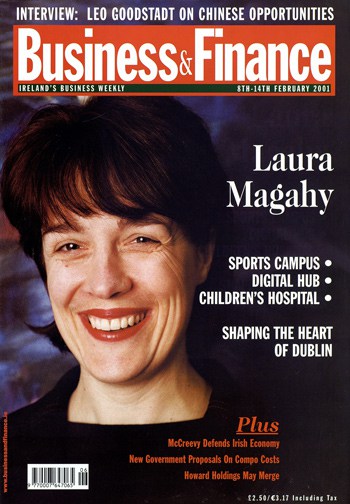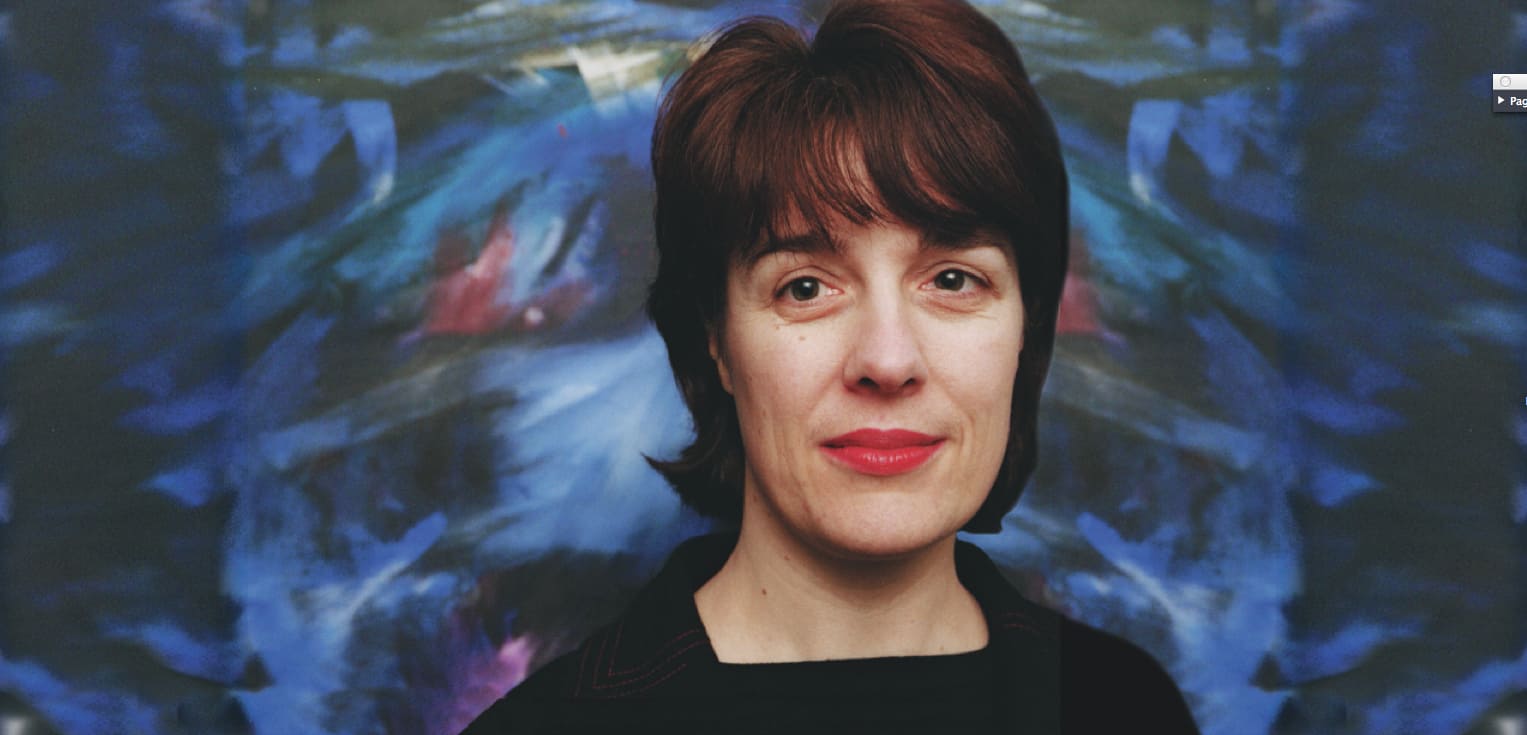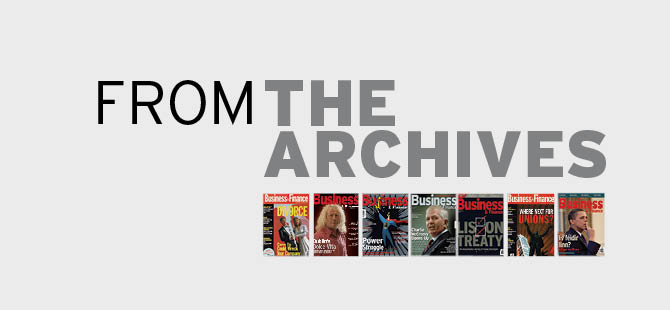Numerous absorbing and dynamic interviews and features have graced the pages of Business & Finance during its history. From the Archives looks back at a selection of articles and shows how the Irish economy has evolved through the decades.
Laura Magahy, 2001
Laura Magahy, the former head of Temple Bar Properties, speaks to Tom McEnaney about three of the largest projects ever undertaken in Dublin – Stadium Ireland, the new Mater Children’s Hospital and the Digital Hub in Dublin’s Liberties.
Less than two years after stepping down as managing director of Temple Bar Properties, Laura Magahy finds herself responsible for some of the most ambitious projects ever undertaken in Dublin.
Counted in pounds the value of the projects certainly exceeds £1bn and could easily run to twice that. But monetary value alone would not do justice to the importance of what has been vested in this 39-year-old woman with a reputation for getting things done.
Her involvement with the National Sports Campus, which includes Stadium Ireland, is already well known, and caused some controversy recently when it emerged that the consortium she leads will receive 1.8% of the overall capital cost. This estimated cost itself has caused some controversy and currently stands at £550m. With projects of this size however it is not unusual for the true cost to be much greater than the estimate.
What is less well known is that Magahy & Co., which employees 25 people, some of whom are Magahy’s former colleagues at Temple Bar Properties, has also won the contract to implement the £230m new children’s hospital on the site of the car park of the Mater Public Hospital.
Nor is it widely known that her company is leading the consortium charged with implementing the Digital Hub for the Liberties area of Dublin. The cost of this initiative is not yet known, but the anchor project alone, the Media Lab, is valued at £130m.
While Magahy will personally oversee both the hospital and stadium projects, executive responsibility for the proposed Digital Hub will fall to her fellow director and former TBP partner Eve-Anne Cullinan.
 CAPITAL CONTRACTS
CAPITAL CONTRACTS
So how has one very young company managed to secure some of the most lucrative contracts in the capital? According to Magahy, the answer is simple. Magahy & Co., she says is the only company of its kind and therefore is uniquely qualified for the projects it has taken on. As for her personal qualities, she describes herself as “practical, creative and optimistic”.
Magahy can definitely be credited with overseeing the rejuvenation of the area into perhaps the main cultural centre of Dublin
She eschews the description “property company” or “project management company” and instead chooses to define her own terms. “We are a development management company and provide a totally new type of service compared to traditional project management,” says Magahy. “We are filling the niche for clients who want a virtual organisation to deliver project-based initiatives.”
Magahy & Co, might advise not just on the project, but on the financing. It might, she said, be involved in “describing the model, developing the brief and raising the finance”. And unlike consultancy companies, her role does not stop at advising. In each of the projects she has taken on, the company is responsible for making the project happen.
“There is a big gap in the market for people who can make it happen,” says Magahy. In fairness to Magahy, those who dealt with her at Temple Bar Properties sing a similar tune. She is known as a charming and intelligent woman with great energy who always manages to get the job done.
The Temple Bar phenomenon was about more than one person. The two-year nine-month contracts which arose out of CIE’s determination to turn the area into a bus station led to low rents, which in turn facilitated a colourful mix of alternative residents.
That said, even before being appointed as finance and culture director of TBP in 1991, Magahy was active, as a founder of the Irish Film Centre in securing the area’s future. When the then managing director of TBP, Paddy Teahon, stepped down to become secretary of the Department of An Taoiseach, Magahy took hold of the reins.
CENTRE FOR CULTURE AND TECH
Magahy can definitely be credited with overseeing the rejuvenation of the area into perhaps the main cultural centre of Dublin and, indeed, one of the best-known cultural centres in Europe.
Interviewed while in that role, she said that if she had one regret it was not bringing more enterprise to the area. Temple Bar has some of the best arts centres in the country, but is not known for enterprise.
Magahy and Cullinan will certainly have an opportunity to address that imbalance with the Digital Hub, which will be based around an as-yet-unspecified area in the vicinity of the Guinness Hobstore. The Digital Hub epitomises what Magahy would like to see her company concentrate on; large-scale public projects or what she terms “les grands projets”.
“The Digital Hub will cluster activity in world-class research and development into enterprise in digital media start-up and emerging digital media companies,” according to the project’s own brochure.
According to Magahy, the project is at the “advanced feasibility stage”. This involves extensive consultation with the local community, doing what Magahy calls the “financial engineering” and securing sites. For obvious reasons she would not be drawn on which sites the group is interested in but did concede that they were looking at seven groups of properties, which are both publicly and privately owned.

POLITICAL SWAY
Magahy does not court publicity and was at pains to point out that this would be her only press interview this year. An attractive, successful woman who has always enjoyed a high-profile position, it is not surprising that she has received more than a little attention. But while Magahy was seen as the public face of Temple Bar, she is keen to stress that she is not the face of any of the projects she has since taken on.
In the case of the Sports Campus and Stadium, and the Digital Hub, the man who is the public face is Paddy Teahon. The former secretary of the Department of An Taoiseach, not to mention Magahy’s former boss, is chairman of Campus and Stadium Ireland Limited, and executive chairman of Digital Media Development Limited.
Magahy is adamant that what she is doing goes far beyond the role of traditional property developers
Magahy obviously has close links to the taoiseach himself. Not only is she, under Teahon’s supervision, the minder of two of his most ambitious pet projects, but it was the taoiseach together with the then health minister, Brian Cowen, who announced funding for the Mater project, which, of course, is in Ahern’s constituency.
And although Magahy’s consortium for the Sports Campus and National Stadium includes the PR firm Wilson Hartnell, it is Teahon who is fielding the flak for the oft-times controversial project. Perhaps the main criticism levelled at the stadium is that is a poor use of public resources at a time when the FAI is planning its own stadium and many people are having to wait years for potentially life-saving medical operations.
CONSOLIDATION
As the person charged with implementing both the £550m stadium and campus and the £230m hospital, Magahy is perhaps uniquely placed to comment on whether the £550m could be better spent. Not surprisingly, she demures, conceding only that: “It’s a legitimate question.”
Magahy is adamant that what she is doing goes far beyond the role of traditional property developers who, she says, “are mostly only interested in the bottom line”. “There is more to it than the bottom line. It’s about what you can put back into the community. If somebody came to us and said will you do this shopping centre or this office complex we’d have to say to them that it’s not something we would be interested in at the present time.”
And while Magahy maintains that she is “always interested in interesting projects” it’s probably fair to say that she has enough on her plate at the moment. “The Digital Hub is not at full tilt at the moment and so we will just consolidate and keep our heads down.”
DUBLIN’S DIGITAL HUB
One of Dublin’s most high-profile PR consultants, Bride Rosney, is tramping the streets in the Liberties area of Dublin, canvassing the opinion of locals about the Digital Hub proposed for this are of Dublin. Although still at the feasibility stage, those behind the project know the importance of community support and so have tried to involve the local community at an early a stage as possible.
Rosney, however, is not leading the team charged with making this project happen. That responsibility fall on Eve-Anne Cullinan, who followed Laura Magahy from Temple Bar Properties to become a director of Magahy & Co. If the team of people involved in this project is anything to go by, it stands every chance of success. That team includes people from BDO Simpson Xavier, Dublin Corporation, Enterprise Ireland and PriceWaterhouseCoopers.
The scale of the project has not yet been finalised but one thing is certain – this will be big. As Charles Haughey can be credited with saving Temple Bar for Dublin, Bertie Ahern has set his sights on the area around the Guinness Brewery, which has managed to stubbornly resist the rapid development which has typified much of the rest of the capital.
And as Temple Bar concentrated on the arts and tourism, the Digital Hub will concentrate on technology and education, with a strong community involvement. E-cinema, e-music, digital television and all the concepts associated with the digital age will be encouraged and fostered in the new digital village. As well as being a natural home for high-tech education, it is hoped that the centre will have a strong business element and, indeed, is expected to have a significant arts involvement.
AN ENTIRELY DIFFERENT MATER
In her last 18 months as managing director of Temple Bar Properties Magahy was already working on a part-time basis. She was approached by the Sisters of Mercy, who had £25m to spend on new A&E and outpatients departments. Magahy held discussions with the order which led to the project being greatly increased to a new £230m hospital.
The Sisters of Mercy for their part did a deal with the Sisters of Charity which led to agreement to move Temple Street Children’s Hospital to a site on the Mater campus, and in March 1999 Magahy was appointed as executive director of the project, while maintaining her role as managing director of Temple Bar Properties.
Although this was her first move since taking on the TBP job Magahy maintains that she had been “peeping over the parapet” for a while beforehand. The amount of money devoted by the government to the project has steadily risen to £195m. At the same time the scope of the project has also increased. The new hospital, which will be associated with the Mater Public, will have an A&E and outpatients departments, new operating studios, a radiology unit and a day services centre.
As well as the £195m contributed by the government, Magahy is also currently sourcing a further £35m. This will come from the private sector although in what form is not yet known. It could be a loan, or a private partner could take an interest in the car parks or shops which will be part of the new development. Visitors to the hospital are likely to see some of Magahy’s own personality in the building. For instance, one of the people brought in to consult on the project is Martin Drury, director of children’s cultural centre in Temple Bar, the Ark. The hospital is expected to be completed in 2008.
SETTING THE SCENE – 2001
While the Digital Hub has certainly proven to be a success, few in 2001, least of all Laura Magahy, could have predicted the controversy both Stadium Ireland, aka ‘Bertie Bowl’ and the national children’s hospital were to cause.
While the Bertie Bowl sank before it even got into the water, the children’s hospital has been an ongoing concern for a number successive governments. According to the most recent progress reports the hospital now won’t be completed until 2019.
Equally, in 2001, few could deny the dominance of the events of September 11th on the world’s headlines – all eyes were well and truly facing west in the latter end of the year and indeed into 2002 and beyond. Also in 2001, foot-and-mouth disease hit our shores; the GAA abolished Rule 21; and Irish voters reject the Treaty of Nice.






